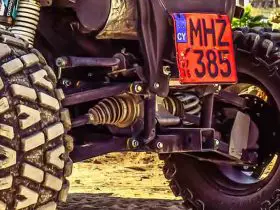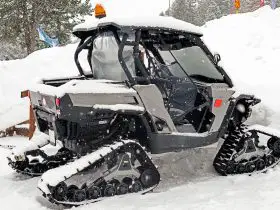UTV’s are becoming more and more popular, not just with hunters. Many people now routinely use these machines for routine transportation. Maintenance of a UTV is as critical as car maintenance. One place that owners often overlook is the UTV’s braking system.
The braking system is critical for the safe operation of your UTV. Maintenance of the brakes ensures safe stopping and fewer accidents. Changing the brakes on a UTV is not a difficult project and can be performed by most UTV owners by following a few simple steps.
Table of Contents
How to change brakes on a UTV
1) Gather Your Tools and Parts
Before you start any job, it is always a good idea to gather the tools and parts needed to complete the job. Having everything close at hand will eliminate frustration and make the job go much smoother. Eliminating the need to search for tools or run to the parts store for additional parts saves time.
In general, you will need the following tools.
- A socket set with the appropriate size of sockets and a drive
- A C-clamp large enough to push the brake caliper piston back into place
- Vice grips to help remove the old brake pads
- A jack to lift the wheel of the UTV high enough to remove the tire
- A socket or lug wrench for the wheel nuts
- A torque wrench for replacing the lug nuts properly
- Gloves to protect your hands
- Safety glasses to protect your eyes
- The new brake pads for your UTV
2) Inspecting the Brake System from Top to Bottom
UTVs often take a lot of wear and tear, especially during off-road activities. Changing the brake pads on your UTV is a perfect time to perform this inspection. Check all the lines, reservoirs, and cylinders for leaks.
The Reservoir should be full of the recommended type of brake fluid. Many cylinders will have rubber boots protecting the cylinders from dirt. Make sure that these rubber boots are in place and are not torn or damaged.
Fix any leaks and replace any damaged parts before going on with your brake pad change. A well maintained braking system will ensure you can stop with confidence.
3) Getting to the Brakes – Remove the Wheel
Jack up your UTV. Look in the owner’s manual for the proper place to position the jack for each wheel. Raising the UTV using the wrong lifting point can damage the suspension or bodywork of your UTV. Set the wheel aside.
It would be best if you loosened the lugs before you lift the wheel free of the ground. Only raise the wheel completely off the ground when the lug nuts are easy to turn. Put the lug nuts in a safe place so you can find them easily when it is time to replace the wheel.
4) Which Do You Have – Drums or Discs?
Some older UTV’s have drum brakes rather than disc brakes. If you find brake drums rather than disc brakes, stop before you go any further. Drum brakes require a different process and different tools. The rest of these step by step instructions only cover UTV’s with disc brakes
5) Remove the Caliper from the Disc
Find the right size socket to fit the bolts that hold the caliper to the suspension of your UTV. There are usually two bolts that face inward. Carefully loosen these bolts and remove them. Removing the bolts should allow the caliper assembly to slide free of the disc.
Be careful with the hose attached to the caliper assembly. Try not to kink this hose or bend it too much.
NOTE: The bolts that hold the caliper to the brake assembly may need a large Allen wrench instead of a socket. Allen head bolts are not usual.
6) Off with the Old – Remove the Old Brake Pads
Remove the clips that hold the brake pads into place. The vice grips may make this part easier. The vice grips will help suppress or compress the pins that hold the brake pads into place on the caliper. When the pins compress fully, the old brake pads should slip free of the caliper.
In some cases, new clamps come with the new brake pads. If your new brake pads include new clamps, discard the old clamps, and use the new clamps when installing the new brake pads.
Pay attention to the old brake pads as you remove them. Some disc brake systems have different pads for the inside and outside of the caliper. You must put the proper pad back into the proper place, so looking at the old brake pads is important.
7) Inspect the Caliper and the Disc
Now is a good time to take a quick look at the caliper and the disc. Check the caliper for wear and tear. Some calipers have a rubber boot protecting the piston and the connection with the brake line. If these boots are torn or worn, replace them.
The surface of the disc on your UTC should be smooth and free of any gouges or groves. If the brake pads have cut grooves into the disc, you may need to remove the disc for resurfacing or replacement.
8) On with the New – Install the New Brake Pads
Use the C-Clamp to compress the piston on the caliper down to its lowest point. You won’t get the caliper back over the disc if you don’t perform this step. We suggest that you use one of the old brake pads to protect the surface of the piston from the c-clamp.
When the piston is at its lowest point, you can install the new brake pads. If the new pads came with new spring clamps, install them as well. Make sure that you get the right pad on the correct side of the caliper. Some brake systems have different pads for the inside and outside positions on the caliper.
9) Replace the Caliper on The Disc
Put the caliper back over the disc and align the bolt holes. If the caliper doesn’t slip easily over the disc, make sure the caliper piston is fully depressed, and the brake pads are in the correct position. Replace the bolts and tighten them.
Before you replace the wheel, pump the brake pedal a few times to check that the brake pads are moving and pressing against the disc. Check for leaks around the caliper where the brake line attaches and on the caliper piston.
10) Getting Back on the Ground – Replace the Wheel
With the brake pad installation done, you are ready to replace the wheel and remove the jack. When replacing the wheel, make sure that you tighten the lug nuts to the proper torque setting. Your owner’s manual that came with your UTV has the specifications for torqueing the lug nuts
11) On to the Next Wheel – Do Them All at The Same Time
Never replace the brake pads on just one wheel. You should replace all the brake pads on your UTV at the same time. Having new brake pads on all the calipers ensures that they operate evenly and safely.
A Job Well Done – Now Hit the Road
Maintaining your UTV, especially the braking system, can add years of enjoyment. The knowledge that the brakes on your UTV are at their peak means you can drive and enjoy your UTV with your family and friends without worry. With the brakes inspected and the pads changed, it is time to get that UTV out on the road for some good times.






